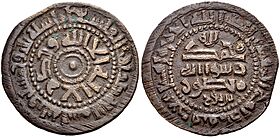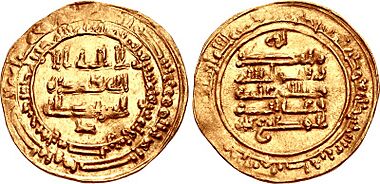- This page was last modified on 17 October 2025, at 10:18. Suggest an edit.
al-Muti' facts for kids
| al-Mutīʿ li-ʾllāh المطيع لله |
|||||
|---|---|---|---|---|---|
| Caliph Commander of the Faithful |
|||||

|
|||||
| 23rd Caliph of the Abbasid Caliphate | |||||
| Reign | 28 January 946 – 5 August 974 | ||||
| Predecessor | al-Mustakfi | ||||
| Successor | al-Ta'i | ||||
| Born | 913/14 Baghdad |
||||
| Died | 12 October 974 (aged 60) Dayr al-Aqul |
||||
| Burial | al-Rusafa, Baghdad | ||||
| Consort | Utb | ||||
| Issue | al-Ta'i | ||||
|
|||||
| Dynasty | Abbasid | ||||
| Father | al-Muqtadir | ||||
| Mother | Mash'ala | ||||
| Religion | Sunni Islam | ||||
al-Mutīʿ li-ʾllāh (meaning "Obedient to God") was an Abbasid caliph who ruled in Baghdad from 946 to 974. His full name was Abū ʾl-Qāsim al-Faḍl ibn al-Muqtadir. During his time, the Abbasid Caliphate had very little real power.
Al-Muti' ruled under the control of the Buyid dynasty, a powerful family of rulers. He was mostly a symbolic leader, like a "rubber stamp," meaning he approved decisions made by others. Even so, he had some authority over religious and legal appointments in Iraq. Unlike earlier caliphs who were often removed quickly, al-Muti' had a long and stable reign. He was even able to pass the throne to his son, al-Ta'i.
However, al-Muti's standing as the leader of the Muslim world became much weaker. Other rulers saw him as a puppet of the Buyids. His inability to stop the Byzantine army from advancing also hurt his reputation. The rise of Shi'a Muslim groups, like the Fatimid Caliphate, also challenged the traditional Sunni Abbasid rule. The Fatimids even conquered Egypt and threatened Baghdad itself during al-Muti's reign.
Contents
The Life of Caliph al-Muti'
Early Years
The future Caliph al-Muti' was born in Baghdad around 913 or 914. His birth name was al-Fadl. He was the son of an earlier Abbasid caliph, al-Muqtadir, and a woman named Mash'ala. He was also the brother of two other caliphs, al-Radi and al-Muttaqi.
Al-Fadl grew up during a difficult time for the Caliphate. His father's rule saw many conflicts and money problems. The caliphs lost control of their lands to powerful military leaders. These leaders fought among themselves for control of Baghdad and the title of amir al-umara (commander-in-chief). This title gave them control over the government.
Caliph al-Muttaqi tried to regain power but failed. He was removed from power and lost his sight in 944. As the main son of al-Muqtadir still alive, al-Fadl was a likely choice for the next caliph. However, the amir al-umara at the time chose al-Mustakfi instead. Al-Fadl and al-Mustakfi did not get along. When al-Mustakfi became caliph, al-Fadl went into hiding.
Becoming Caliph

The lands controlled by the Buyid dynasty around 970 CE. They ruled Iraq and parts of Iran.
In December 945, the Buyid army, led by Mu'izz al-Dawla, took control of Baghdad. Mu'izz al-Dawla became the real power behind the caliph. On January 29, 946, al-Mustakfi was removed from power. On the same day, Mu'izz al-Dawla made al-Fadl the new caliph. He was given the new name al-Muti' li-'llah, meaning "Obedient to God."
It was a surprise to many that al-Muti' suddenly became caliph. Some stories say he had secretly planned with the Buyids. Historians believe Mu'izz al-Dawla wanted a caliph he could fully control. This way, the caliph would not have outside support.
The deposed caliph, al-Mustakfi, was made blind. He remained a prisoner in the palace until he died in 949.
His Role as Caliph
Al-Muti' was a weak leader. He was a puppet ruler for the Buyid leaders, first Mu'izz al-Dawla, then his son Izz al-Dawla. Because he had little real power, al-Muti' is not mentioned much in historical records. Many historians see his reign as the lowest point for the Abbasid Caliphate.
Even though the Buyids held the real power, they still acted in the caliph's name. All official appointments and legal actions were done in his name. Al-Muti' lived a comfortable life in the caliph's palaces. In return, he gave the Buyid rulers legitimacy in the eyes of the Muslim world. The Buyids were Shi'a Muslims, but they kept a Sunni Abbasid caliph. This helped them keep the Sunni majority loyal and gave them more respect from other Muslim rulers.
The Buyids quickly became part of the traditional Abbasid system. They sought titles and official papers from the caliph to show their authority. However, al-Muti' was like a paid government official. His main jobs were overseeing judges, religious groups, and the affairs of the Abbasid family. The caliph's chief secretary was no longer called a 'vizier' (a powerful minister). His job was limited to managing the caliph's personal property and formal appointments.
The Buyids watched the caliph closely. They worried he might try to join their enemies, like the Hamdanids. During battles in 946, al-Muti' was kept under house arrest. He was not released until he promised loyalty to the Buyids. If the Buyid ruler went to fight rebels, al-Muti' was often forced to go with him. This was to prevent him from escaping to the Hamdanids.

A gold dinar coin from 966, showing the name of al-Muti'. This coin was made in Ramla, Palestine.
When Mu'izz al-Dawla took power, he took over the caliph's lands to pay his army. Al-Muti' received a daily salary. Later, he was given more lands, which greatly increased his income. This money allowed him to support other members of the Abbasid family and give gifts to the Kaaba in Mecca. He also used the money to build new parts of the caliphal palace.
Over time, the relationship between the caliph and the Buyids became more peaceful. The Buyids respected the caliph's remaining duties. Al-Muti' seemed to accept his less powerful role. He even had good relations with Mu'izz al-Dawla. In 955, Mu'izz al-Dawla even made his 13-year-old son, Izz al-Dawla, the caliph's personal assistant.
Al-Muti' reigned for almost 30 years, which was very long compared to the short reigns of earlier caliphs. He faced few rivals trying to take his place. One grandson of an earlier caliph tried to claim the title in Armenia in 960 but was defeated. In 968, a son of al-Mustakfi tried to pretend he was the Mahdi (a messianic figure in Islam) in Iraq. He gained some support but was eventually caught. Al-Muti' did not punish him severely, and the caliphate stayed in al-Muqtadir's family line.
Facing Challenges from Shi'a and Byzantines
Outside the Buyid lands, the Abbasid caliph's power continued to shrink. The Samanids in Khurasan did not recognize al-Muti' as caliph for a time. In the west, the Fatimid Caliphate, a rival Shi'a group, grew stronger. They conquered Egypt in 969 and began expanding into the Levant.
Even in Baghdad, the Buyids' support for Shi'a beliefs led to more Shi'a influence. New Shi'a practices were introduced, like celebrating the Ghadir Khumm festival. There were often street fights between Sunni and Shi'a groups in Baghdad.
Al-Muti' played a role in forming a group against the Fatimids. This group included the Qarmatians and the Hamdanid ruler of Mosul, with Buyid support. This alliance stopped the Fatimid expansion for a while. The Qarmatians even recognized al-Muti' as their leader. In 951, when the Qarmatians returned the Black Stone to the Kaaba, al-Muti' is said to have paid a large sum for it.
Another threat came from the Byzantine Empire. In the 960s, the Byzantines captured lands from the Hamdanids in northern Syria. By 972, Byzantine raids reached cities like Nisibis. Muslim refugees fled to Baghdad, asking for protection. Since the caliph was formally in charge of holy war (jihad), Izz al-Dawla told them to go to al-Muti'.
Al-Muti' had no army or money to help. His reputation suffered greatly. Izz al-Dawla then pressured al-Muti' to sell his valuables. He wanted the money to hire soldiers against the Byzantines. Al-Muti' protested but had to agree. However, the money was quickly wasted by the Buyid ruler. This made many Sunni Muslims in Baghdad even more upset with Izz al-Dawla.
Giving Up the Throne and Death
Over time, Izz al-Dawla angered his own Turkish soldiers. In August 974, the Turkish commander Sabuktakin took control of Baghdad from Izz al-Dawla.
When this happened, al-Muti' left Baghdad with the Buyid family. But Sabuktakin forced him to return to his palace. Al-Muti' was old and had suffered a stroke in 970, which paralyzed his right side. He was persuaded to give up his throne due to his poor health. His son, Abd al-Karim, became the new caliph, al-Ta'i, on August 5. This was the first time a caliph had passed the throne directly to his son since 902.
Sabuktakin became the amir al-umara for the new caliph. He left Baghdad to fight the Buyids, taking both al-Muti' and al-Ta'i with him. Al-Muti' died on the journey, on October 12, 974. He was buried in Baghdad.
See Also
Sources
- Bowen, Harold (1928). The Life and Times of ʿAlí Ibn ʿÍsà, ‘The Good Vizier’. Cambridge: Cambridge University Press. OCLC 386849. https://archive.org/details/in.ernet.dli.2015.76926.
- Brett, Michael (2001). [Al-Muti' at Google Books The Rise of the Fatimids: The World of the Mediterranean and the Middle East in the Fourth Century of the Hijra, Tenth Century CE]. The Medieval Mediterranean. 30. Leiden, Boston, Köln: Brill. ISBN 90-04-11741-5. Al-Muti' at Google Books.
- "Buwayhids or Būyids". The Encyclopaedia of Islam, New Edition, Volume I: A–B. (1960). Leiden: E. J. Brill. 1350–1357.
- Donohue, John J. (2003). [Al-Muti' at Google Books The Buwayhid Dynasty in Iraq 334 H./945 to 403 H./1012: Shaping Institutions for the Future]. Leiden and Boston: Brill. ISBN 90-04-12860-3. Al-Muti' at Google Books.
- Güner, Ahmet (2006). "Mutî‘-Lillâh". TDV Encyclopedia of Islam, Vol. 31 (Muhammedi̇yye – Münâzara). Istanbul: Turkiye Diyanet Foundation, Centre for Islamic Studies. 401–402.
- Kennedy, Hugh (2004). [Al-Muti' at Google Books The Prophet and the Age of the Caliphates: The Islamic Near East from the 6th to the 11th Century] (Second ed.). Harlow: Longman. ISBN 978-0-582-40525-7. Al-Muti' at Google Books.
- Le Strange, Guy (1922). Baghdad During the Abbasid Caliphate. From Contemporary Arabic and Persian Sources (Second ed.). Oxford: Clarendon Press. https://archive.org/details/in.ernet.dli.2015.68175.
- Özaydin, Abdülkerim (2006). "Müstekfî-Bi̇llâh". TDV Encyclopedia of Islam, Vol. 32 (el-Münci̇d – Nasi̇h). Istanbul: Turkiye Diyanet Foundation, Centre for Islamic Studies. 139–140.
- Tor, Deborah (2014). "ʿAyyār". Encyclopaedia of Islam, THREE. Brill Online. DOI:10.1163/1573-3912_ei3_COM_24259.
- Zetterstéen, K. V. (1993). "al-Muṭīʿ Li ’llāh". The Encyclopaedia of Islam, New Edition, Volume VII: Mif–Naz. Leiden: E. J. Brill. DOI:10.1163/1573-3912_islam_SIM_5674.
|
al-Muti'
Born: 913/14 Died: 12 October 974 |
||
| Sunni Islam titles | ||
|---|---|---|
| Preceded by al-Mustakfi |
Caliph of the Abbasid Caliphate 29 January/9 March 946 – 5 August 974 |
Succeeded by al-Ta'i |
